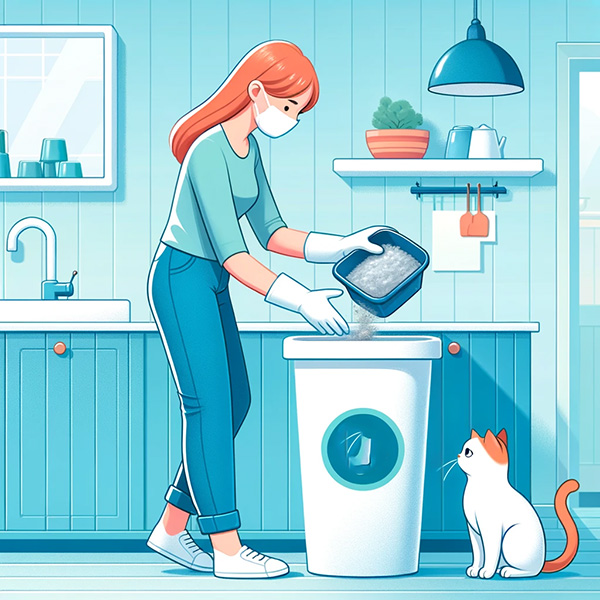Are you a devoted cat owner seeking the most effective method to manage your feline companion's litter? You've come to the right place! Keeping a tidy and odor-free litter box is crucial for the health and happiness of your cat, as well as maintaining a peaceful atmosphere in your household, as any experienced cat guardian can attest. But what about the responsible disposal of used cat litter?
In this detailed guide, we will delve into all the essential aspects of safely and effectively disposing of cat litter while also reducing environmental impact as much as possible. From eco-friendly disposal methods to tips for keeping your home smelling fresh, we've got you covered.
3 Ways To Dispose Cat Waste
Trash

Disposing cat litter in the trash can is the most common and straightforward method for many cat owners. This approach is suitable for all types of cat litter, encompassing clay and silica varieties, ensuring its universal applicability for cat owners regardless of the type of litter they use. Traditional clay litter, in particular, is widely compatible with this method due to its ability to form clumps when wet, making it easy to scoop and dispose of. Silica gel litter, consisting of absorbent crystals, is also well-suited for trash disposal, effectively controlling odors.
The main advantage of disposing of cat litter in the trash is its convenience. It requires minimal effort and is accessible to most cat owners, as it only involves using a cat litter scoop to sift out waste into a plastic bag and tie it securely before placing it in the household trash bin. However, choosing a sturdy trash bag or double bag is essential to prevent leaks or tears, particularly if the litter is wet or odorous.
One significant drawback is its environmental impact, especially with non-biodegradable clay litter. Traditional clay litter contributes to landfill waste, and its disposal can pose challenges in terms of odor control if not managed promptly. Despite these drawbacks, the simplicity and accessibility of tossing cat litter into the trash make it a practical option for many cat owners. Certain cat owners choose biodegradable or compostable trash bags as an environmentally conscious option to reduce their ecological footprint when disposing of cat litter.
Compost

Compost cat waste offers an eco-conscious choice for cat guardians seeking to reduce their environmental impact. Biodegradable cat litter, often composed of natural materials like wood shavings, paper, or plant-based fibers, is ideal for this approach. These litters readily decompose in compost piles, enhancing soil quality and mitigating landfill waste.
Composting cat litter offers several benefits, including sustainability and odor control. By redirecting cat's litter waste away from landfills, it does not only reduce environmental impact but also promotes eco-friendly practices. Compostable or biodegradable litter, often crafted from natural materials like wood, paper, or plant-based fibers, is well-suited for composting.
To compost cat litter safely, creating a separate composting system specifically for pet waste is important to prevent contamination of other compostable materials. Cat waste should be composted in a dedicated bin or pile, away from edible plants and vegetables, and follow proper composting guidelines to ensure safety and effectiveness.
However, composting cat litter also has its drawbacks. Cat feces may contain harmful pathogens, so following proper composting guidelines is essential to minimize health risks. Composting requires dedicated space and time for managing compost piles or bins, making it less convenient than other disposal methods. Additionally, some municipalities may have restrictions or guidelines regarding pet waste composting, so it's important to research local regulations before composting cat litter.
Flushing

Flushing cat litter down the toilet is a convenient and hygienic disposal method, particularly for cat owners seeking to minimize odor and mess. Flushable cat litters, typically made from natural materials like corn, wheat, or recycled paper, are best suited for this method. These litters break down quickly in water, reducing the risk of plumbing issues and environmental pollution.
Flushing cat litter offers multiple advantages, including convenient disposal and minimal environmental impact. By eliminating the need to handle or transport waste to the trash, flushing simplifies the cleanup process and helps keep the home clean and odor-free.
However, it's crucial to check with your local wastewater treatment facility to ensure that flushing cat litter is permitted in your area, as some municipalities may have restrictions or guidelines in place. Many areas do not recommend flush cat poop as cat poop can contain toxoplasma, an organism that can cause diseases in human and aquatic life. For this reason, it's important to consult your local guidelines. Additionally, it's important to flush cat litter in small quantities to avoid overwhelming plumbing systems and causing clogs or blockages.
